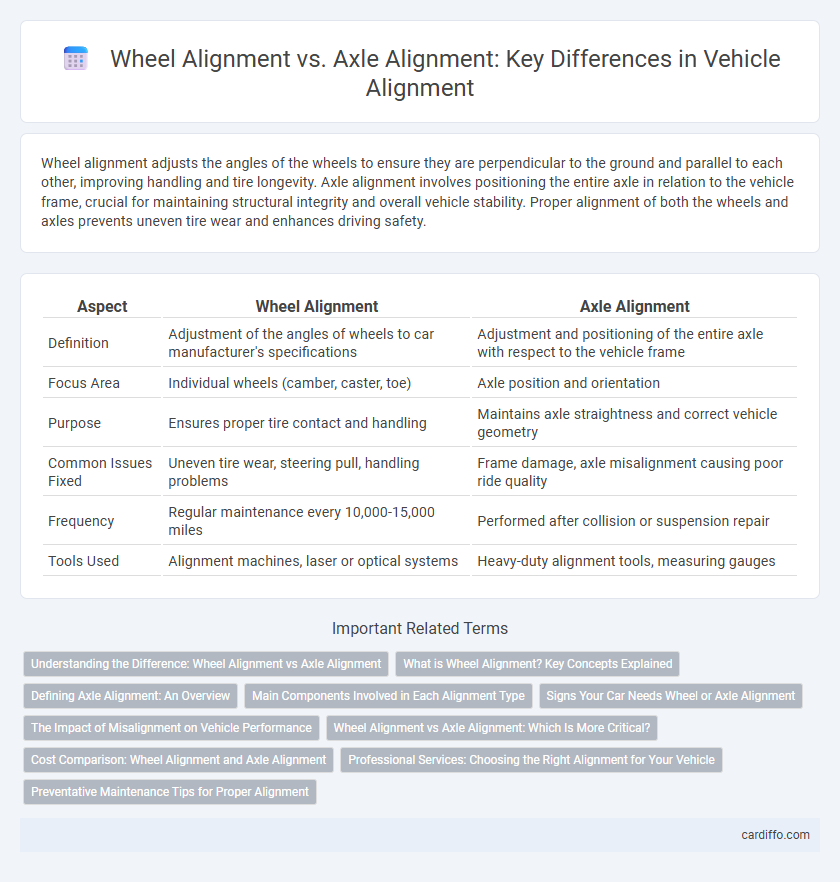Wheel alignment adjusts the angles of the wheels to ensure they are perpendicular to the ground and parallel to each other, improving handling and tire longevity. Axle alignment involves positioning the entire axle in relation to the vehicle frame, crucial for maintaining structural integrity and overall vehicle stability. Proper alignment of both the wheels and axles prevents uneven tire wear and enhances driving safety.
Table of Comparison
| Aspect | Wheel Alignment | Axle Alignment |
|---|---|---|
| Definition | Adjustment of the angles of wheels to car manufacturer's specifications | Adjustment and positioning of the entire axle with respect to the vehicle frame |
| Focus Area | Individual wheels (camber, caster, toe) | Axle position and orientation |
| Purpose | Ensures proper tire contact and handling | Maintains axle straightness and correct vehicle geometry |
| Common Issues Fixed | Uneven tire wear, steering pull, handling problems | Frame damage, axle misalignment causing poor ride quality |
| Frequency | Regular maintenance every 10,000-15,000 miles | Performed after collision or suspension repair |
| Tools Used | Alignment machines, laser or optical systems | Heavy-duty alignment tools, measuring gauges |
Understanding the Difference: Wheel Alignment vs Axle Alignment
Wheel alignment focuses on adjusting the angles of the wheels to ensure they are parallel and perpendicular to the ground, optimizing tire wear and vehicle handling. Axle alignment involves correcting the position of the axle itself to ensure it is properly centered and aligned with the vehicle's frame, crucial for preventing uneven load distribution and drivetrain issues. Understanding the difference between wheel and axle alignment helps in targeting specific maintenance needs for improved safety, performance, and tire longevity.
What is Wheel Alignment? Key Concepts Explained
Wheel alignment refers to the precise adjustment of a vehicle's wheels to ensure they are parallel to each other and perpendicular to the ground, optimizing tire contact with the road. Key concepts include camber, caster, and toe angles, which influence handling, tire wear, and vehicle stability. Proper wheel alignment enhances fuel efficiency, extends tire life, and improves overall driving safety.
Defining Axle Alignment: An Overview
Axle alignment refers to the precise positioning and adjustment of a vehicle's axle to ensure it is parallel and properly oriented relative to the frame and wheels. Unlike wheel alignment, which focuses on the angles of individual wheels such as camber, caster, and toe, axle alignment targets the entire axle assembly to prevent uneven tire wear and improve vehicle stability. Accurate axle alignment is essential for maintaining optimal handling, reducing suspension stress, and enhancing overall driving safety.
Main Components Involved in Each Alignment Type
Wheel alignment primarily involves adjusting the angles of the wheels, focusing on components such as tie rods, control arms, and camber bolts to ensure proper wheel orientation. Axle alignment targets the positioning of the vehicle's axle relative to the chassis, emphasizing key parts like the axle beam, axle housing, and suspension brackets. Both alignments require precise calibration of these components to optimize vehicle handling, tire wear, and overall stability.
Signs Your Car Needs Wheel or Axle Alignment
Uneven tire wear, pulling to one side while driving, and a crooked steering wheel are clear signs your car requires wheel alignment. Persistent vibrations or difficulty maintaining a straight path often indicate axle misalignment. Properly diagnosing these symptoms ensures safe handling and prolongs tire lifespan.
The Impact of Misalignment on Vehicle Performance
Misalignment in wheel alignment or axle alignment significantly affects vehicle performance by causing uneven tire wear, reducing fuel efficiency, and impairing handling stability. Incorrect wheel alignment leads to increased tire friction and steering difficulties, while axle misalignment can result in premature drivetrain wear and vibration issues. Both types of misalignment compromise safety, requiring timely adjustments to ensure optimal vehicle control and longevity.
Wheel Alignment vs Axle Alignment: Which Is More Critical?
Wheel alignment ensures each tire points in the correct direction for optimal handling, tire wear, and fuel efficiency, while axle alignment involves positioning the entire axle to maintain vehicle stability. Wheel alignment is generally more critical as misaligned wheels cause uneven tire wear and compromised steering control, directly affecting safety and performance. Though axle alignment supports overall structure, precise wheel alignment delivers immediate and measurable driving benefits.
Cost Comparison: Wheel Alignment and Axle Alignment
Wheel alignment typically costs between $50 and $150, focusing on adjusting the angles of individual wheels to ensure proper contact with the road. Axle alignment, being more comprehensive and involving the straightening or replacement of the vehicle's axle, can range from $300 to $1,000 or more depending on the extent of damage and labor required. Choosing between wheel and axle alignment depends on the vehicle's condition and budget, with wheel alignment being more affordable for routine maintenance and axle alignment necessary for serious structural issues.
Professional Services: Choosing the Right Alignment for Your Vehicle
Professional wheel alignment services ensure precise adjustment of the wheels to the manufacturer's specifications, improving handling, tire life, and fuel efficiency. Axle alignment focuses on correcting the alignment of the vehicle's axle, which is crucial for maintaining structural integrity and preventing uneven tire wear. Choosing the right alignment service depends on your vehicle's specific condition and suspension system, with professional technicians using advanced diagnostic tools to deliver optimal results.
Preventative Maintenance Tips for Proper Alignment
Regular wheel alignment ensures optimal tire wear by maintaining proper camber, caster, and toe settings, preventing uneven tread deterioration. Axle alignment focuses on the correct positioning of the axle relative to the vehicle frame, reducing suspension stress and enhancing stability. Incorporate frequent inspections, timely adjustments, and use of precision alignment tools to maintain both wheel and axle alignment, extending vehicle lifespan and improving safety.
Wheel Alignment vs Axle Alignment Infographic

 cardiffo.com
cardiffo.com